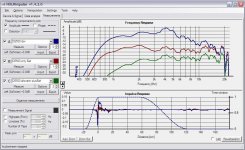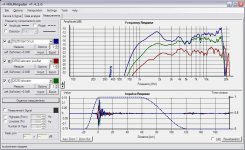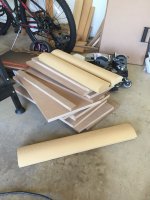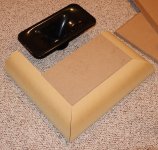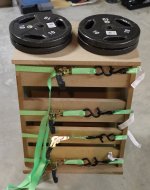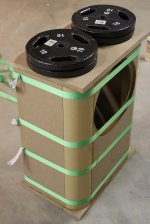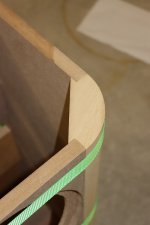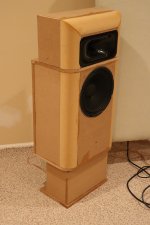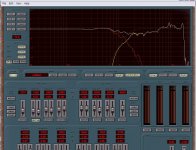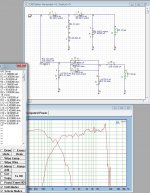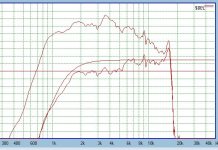Thanks Earl. What are L1 and C1 in your diagram? That response looks very good.
Dan
L1 & C1 currently have no fixed value for the purposes of this HF compensation exercise ( they are simply place holders ).
- For the purposes of this XSim prediction, C1 is shorted and L1 is open .
ie; They'll eventually get assigned values and form the HP circuit ( once you choose a driver ) and you fire up your copy of Sound-Easy.
Hi Earl,
Thanks for the interest. I was just about to post some more questions when I saw your post.
I just received a pair of 2512 Deltalites along with the components to put together the filter you posted. Hopefully some more measurements will be done soon.
One thing I noticed from the cobbled up testing I did so far was that the acoustic center of the CD on the SEOS was more than a couple inches behind the 8" drivers I had been pairing it to. I suspect the 12" deltalite will have an acoustic center a bit further back than an 8". Any suggestions on what woofer mounting would best match the SEOS12? I was originally planning to flush mount the seos and the deltalites but I noticed the deltalites have front as well as rear mounting gaskets. Using the front gasket and putting a radius on the cutout for the deltalites seems like it could have the possibility to better align the drivers as well as reduce some the the diffraction on the front baffle. But it will really depends on where the 2512s acoustic center ends up.
Dan
Thanks for the interest. I was just about to post some more questions when I saw your post.
I just received a pair of 2512 Deltalites along with the components to put together the filter you posted. Hopefully some more measurements will be done soon.
One thing I noticed from the cobbled up testing I did so far was that the acoustic center of the CD on the SEOS was more than a couple inches behind the 8" drivers I had been pairing it to. I suspect the 12" deltalite will have an acoustic center a bit further back than an 8". Any suggestions on what woofer mounting would best match the SEOS12? I was originally planning to flush mount the seos and the deltalites but I noticed the deltalites have front as well as rear mounting gaskets. Using the front gasket and putting a radius on the cutout for the deltalites seems like it could have the possibility to better align the drivers as well as reduce some the the diffraction on the front baffle. But it will really depends on where the 2512s acoustic center ends up.
Dan
Hi Dan,
Bill Waslo ( for his network design ) has good info HERE! ( regarding the mounting plane for the woofer &/or horn ).
BTW, have you choosen an HF driver model yet ?
Thanks for the link Earl. Unfortunately it looks like the pictures have broken links. He mentions the 2512 and the seos12 being in the same mounting plane, but it's not clear to me if they are both flush mounted. I'm inclined to go that route for lower diffraction.
I haven't chosen the compression driver yet. I'm going to do some more measuring and listening with the de500s when I cobble up your circuit. I'm also interested to try the dna-360.
Dan
Some new plots
Here are some measurements I took when comparing the DE250 and the DE500:
The first plot shows the DE500 unequalized, then with Earl's HF compensation circuit, and finally with a little extra EQ supplied by the Frequency Allocator DSP for crossing over to the Silverflute in the test setup. You can see pretty good agreement to Earl's sim run on my previous FR data using Autotech's impedance data.
Dan
Here are some measurements I took when comparing the DE250 and the DE500:
The first plot shows the DE500 unequalized, then with Earl's HF compensation circuit, and finally with a little extra EQ supplied by the Frequency Allocator DSP for crossing over to the Silverflute in the test setup. You can see pretty good agreement to Earl's sim run on my previous FR data using Autotech's impedance data.
Dan
Attachments
Last edited:
And here is a comparison between the DE500 and the DE250. The relative levels of the DE250 and DE500 aren't accurate as I had reduced gain on my amp when I started taking the unequalized data.
Out of curiosity, I tried Earl's HF compensation circuit out on the DE250 but you can see it isn't quite as good a match as it was for the DE500.
Dan
Out of curiosity, I tried Earl's HF compensation circuit out on the DE250 but you can see it isn't quite as good a match as it was for the DE500.
Dan
Attachments
In the end I chose the DE250's over the DE500's. I was able to EQ the DE500 to a very similar response as the DE250 (the EQ'd DE500 response shown above is for a simpler filter that would on the level of complexity I'd be willing to implement in a passive circuit). However, even with the response EQ'd flatter than shown above, the sound was not as subjectively pleasing as from the DE250. I would have liked more time with the DE500's to see if I could get them to give the same subjective performance as the DE250's but unfortunately I ran out of time before they had to go back to Parts Express.
For those interested in sighted subjective impressions:
Perhaps unsurprisingly, there wasn't any noticeable difference in imaging between the two. I would expect the SEOS12 to dominate this aspect rather than the driver. The DE250's had a more relaxed and natural sound to me, especially on strings. Consequently I could listen at louder levels more comfortably. With the DE500's, I felt aware of a slight metallic texture to the sound. It wasn't obnoxious or too objectionable, this coloration just seemed absent on the DE250's. I tried more aggressive EQ on the DE500's which did help somewhat, but the DE250's just sounded right with less effort. The subjective difference to me seemed fairly comparable to a silk vs aluminum dome tweeters I have heard.
Dan
For those interested in sighted subjective impressions:
Perhaps unsurprisingly, there wasn't any noticeable difference in imaging between the two. I would expect the SEOS12 to dominate this aspect rather than the driver. The DE250's had a more relaxed and natural sound to me, especially on strings. Consequently I could listen at louder levels more comfortably. With the DE500's, I felt aware of a slight metallic texture to the sound. It wasn't obnoxious or too objectionable, this coloration just seemed absent on the DE250's. I tried more aggressive EQ on the DE500's which did help somewhat, but the DE250's just sounded right with less effort. The subjective difference to me seemed fairly comparable to a silk vs aluminum dome tweeters I have heard.
Dan
Last edited:
Wow, it's been 3 years. I've been dragging my feet on this project, but made some progress lately. First cabinet is being glued. All internal bracing and 2nd layer of front baffle will be added when dry. The 3" corner rounds seem to fit quite well and give a nice large radius to the front baffle. Seos 12 will be a separate enclosure and sit on top.
Dan
Dan
Attachments
Hi Dan,
You might want to study Jeff Bagby's crossover work for the DIYSG "Tempest".
He achieved a very nice response without resorting to using LCR notch filters.
See;
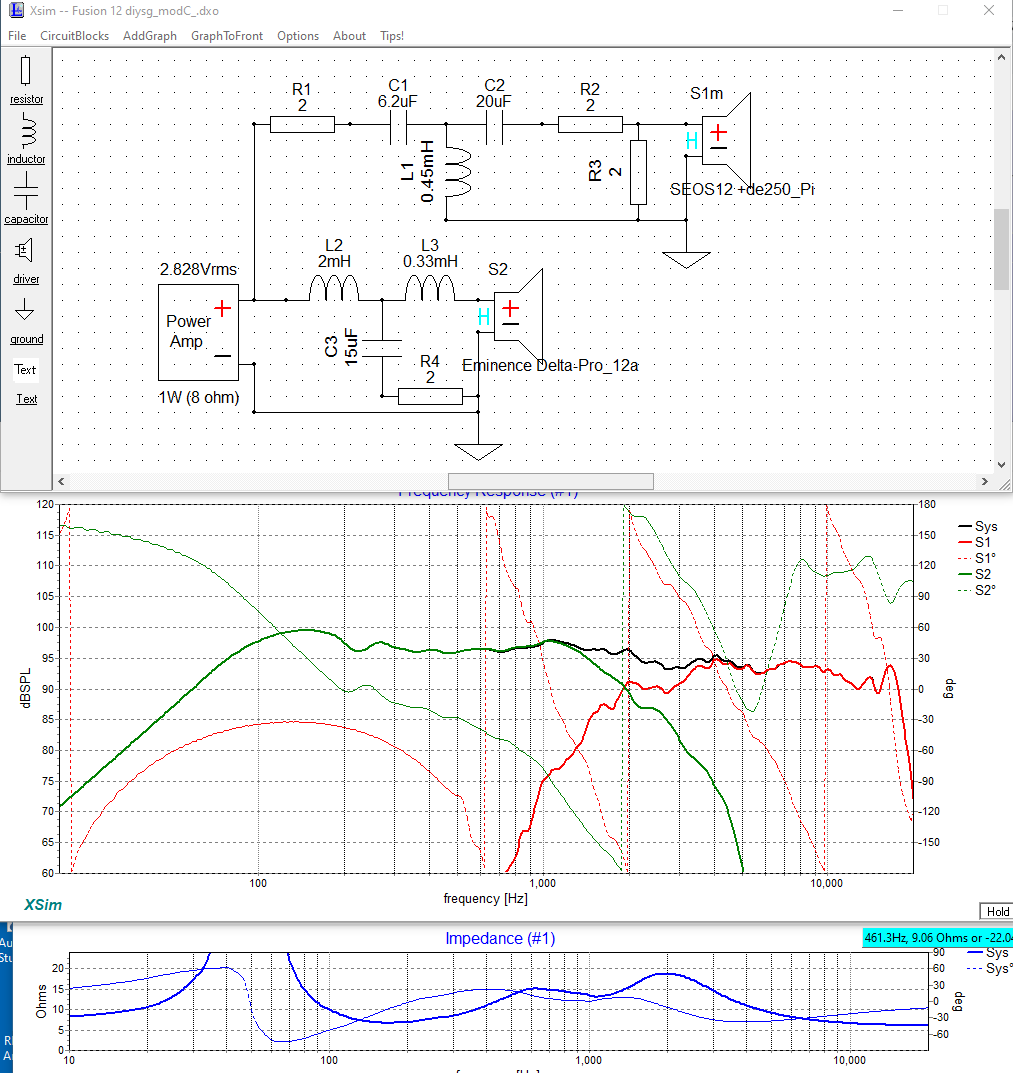
From this thread!
Since you're a measuring sort of guy ( who also uses SoundEasy ) you really shouldn't have much difficulty modifying that network for use with the Delta 2512.
DIYSG ( as well as Zilch from a good decade ago ) have both worked-up networks for that 2512 woofer ( with compression driver loaded waveguides ).
Zilch holding courst within "Flex Your PCD Mettle"

You might want to study Jeff Bagby's crossover work for the DIYSG "Tempest".
He achieved a very nice response without resorting to using LCR notch filters.
See;
From this thread!
Since you're a measuring sort of guy ( who also uses SoundEasy ) you really shouldn't have much difficulty modifying that network for use with the Delta 2512.
DIYSG ( as well as Zilch from a good decade ago ) have both worked-up networks for that 2512 woofer ( with compression driver loaded waveguides ).
Zilch holding courst within "Flex Your PCD Mettle"
Thanks Earl for your continued contribution to this thread even years later! 
I wasn't aware of Jeff's design and that will prove very helpful to me I"m sure. That's encouraging he was able to avoid notch filters. Hopefully I am able to get something as elegant to work for my speakers as well.
Dan
I wasn't aware of Jeff's design and that will prove very helpful to me I"m sure. That's encouraging he was able to avoid notch filters. Hopefully I am able to get something as elegant to work for my speakers as well.
Dan
Hi Earl,
The Tempest 12 response you show, is the crossover point are 2kHz+?
A bunch of updates to come on my project soon. So far results from prototyping responses with digital filters sound pretty amazing.
Is there anywhere the Seos waveguides can still be sourced in the US? I contacted diysg but haven't heard back anything. I have 3 Seos 12's but am now thinking of tracking down at least a couple more to have some spares or go with them for all 5 channels of a 5.1 setup.
Dan
The Tempest 12 response you show, is the crossover point are 2kHz+?
A bunch of updates to come on my project soon. So far results from prototyping responses with digital filters sound pretty amazing.
Is there anywhere the Seos waveguides can still be sourced in the US? I contacted diysg but haven't heard back anything. I have 3 Seos 12's but am now thinking of tracking down at least a couple more to have some spares or go with them for all 5 channels of a 5.1 setup.
Dan
These have been up and running for a while now. I'm tuning the crossovers digitally in Frequency Allocator for now. So far all impressions are extremely positive. I'm not sure I can get away with as simple and elegant a crossover as Jeff Bagby did.
Dan
Dan
Attachments
Thanks norman. They're 3" radius mdf corner rounds. The site I ordered them from doesn't seem to carry them any more. I used up all of what I ordered from them 3 years ago building this pair of cabinets. I might build a center channel and I've found a lead to track down some more. Hopefully it will work as well as these did.
Dan
Dan
At this point I've tried a bunch of crossovers digitally in Frequency Allocator. For those not familiar with this older software, it's a software based digital crossover. The filters are IIR, so minimum phase similar to a passive crossover. I've been using it for quite a few years now to quickly try out different crossover slopes, frequencies, eq., etc. to get a subjective impression of speakers before taking the time to design and build the final passive crossovers.
For now I've settled on about 1300 Hz as the crossover point between the DE250 and the Deltalite. For the Deltalite, an LR 4th order acoustic slope on axis worked well while the DE250 on the Seos needed a slightly steeper crossover to get a good phase match. The acoustic center of the DE250/Seos combination does seem to be about 2" behind that of the deltalite that I've seen mentioned in other threads.
I also tried crossovers as low as 950Hz. 950 actually worked quite well, but sometimes I felt the lower treble got a little strident when the volume was turned up. That seemed to improve with a higher crossover point however I don't really feel completely confident there was actually a difference in that regard.
Anyway, I stuck with the 1300Hz crossover point and have designed a passive crossover with similar response. Attached is the Allocator response prediction about 5 degrees off axis with the final filters. I ended up needing a couple of traps to smooth out the 4khz and 6 khz bumps in the raw response.
I found I definitely needed a BBC dip to get a natural sounding tonal balance. You can see this through the 2-4k region. The treble peak at 9-10khz will most likely be gone with the passive crossovers.
Overall, these are sounding superb. Obviously their dynamic capabilities are good given the sensitivities of the drivers. I have no criticisms of their imaging capabilities either. These are speakers that completely disappear.
Dan
For now I've settled on about 1300 Hz as the crossover point between the DE250 and the Deltalite. For the Deltalite, an LR 4th order acoustic slope on axis worked well while the DE250 on the Seos needed a slightly steeper crossover to get a good phase match. The acoustic center of the DE250/Seos combination does seem to be about 2" behind that of the deltalite that I've seen mentioned in other threads.
I also tried crossovers as low as 950Hz. 950 actually worked quite well, but sometimes I felt the lower treble got a little strident when the volume was turned up. That seemed to improve with a higher crossover point however I don't really feel completely confident there was actually a difference in that regard.
Anyway, I stuck with the 1300Hz crossover point and have designed a passive crossover with similar response. Attached is the Allocator response prediction about 5 degrees off axis with the final filters. I ended up needing a couple of traps to smooth out the 4khz and 6 khz bumps in the raw response.
I found I definitely needed a BBC dip to get a natural sounding tonal balance. You can see this through the 2-4k region. The treble peak at 9-10khz will most likely be gone with the passive crossovers.
Overall, these are sounding superb. Obviously their dynamic capabilities are good given the sensitivities of the drivers. I have no criticisms of their imaging capabilities either. These are speakers that completely disappear.
Dan
Attachments
Some more thoughts on the cabinets, I wasn't sure what to expect. These are by far the largest cabinets I've built and the largest woofers I've used. I had originally planned to use CLD construction but gave up after reading Earl Geddes negative comments on his experience with melamine glue. I didn't want to try microbeads with two-part urethane since ventilation and the potential mess were a concern so I just tried to brace the cabinets as well as I could. The front faces are 2 layers of 3/4" mdf laminated together. The knuckle-rap test seemed to show they were not as rigid as the other smaller bookshelf style speakers I've built.
I haven't yet done any tests of the Seos installed in the cabinets vs sitting on top. I'd like to see if the 3" roundovers were really necessary or not. I'm sure they were overkill, however if cabinet edge diffraction does hurt stereo imaging (and in my limited experience with using felt strips to mitigate it it does seem to have an effect) then the 3" roundovers are providing some benefit.
Thankfully none of this was noticeable when listening to the speakers. I can't hear any "boxy" coloration. I don't think I've raised the resonant frequencies of the cabinet panels above the 1300 Hz crossover point of the woofers, but I really don't notice anything subjectively audible that I would associate with cabinet vibration. The Deltalite II 2512's blend very well to the DE250/Seos 12 combination. The box simulations I ran based on Emminence's publish TS parameters show an F3 of around 60-70 Hz if I remember correctly. My intention for these was to use them with subs, but the bass is quite satisfying from the Deltalite's alone. Maybe that's not too surprising giving a low Q closed box alignment. Anyway, thanks Earl for the 2512 recommendation, they are working out very well so far.
Dan
I haven't yet done any tests of the Seos installed in the cabinets vs sitting on top. I'd like to see if the 3" roundovers were really necessary or not. I'm sure they were overkill, however if cabinet edge diffraction does hurt stereo imaging (and in my limited experience with using felt strips to mitigate it it does seem to have an effect) then the 3" roundovers are providing some benefit.
Thankfully none of this was noticeable when listening to the speakers. I can't hear any "boxy" coloration. I don't think I've raised the resonant frequencies of the cabinet panels above the 1300 Hz crossover point of the woofers, but I really don't notice anything subjectively audible that I would associate with cabinet vibration. The Deltalite II 2512's blend very well to the DE250/Seos 12 combination. The box simulations I ran based on Emminence's publish TS parameters show an F3 of around 60-70 Hz if I remember correctly. My intention for these was to use them with subs, but the bass is quite satisfying from the Deltalite's alone. Maybe that's not too surprising giving a low Q closed box alignment. Anyway, thanks Earl for the 2512 recommendation, they are working out very well so far.
Dan
Here are the passive crossovers designed in Soundeasy to mimic the response curve from Frequency Allocator. In some ways the circuit ended up a little simpler than expected from the Allocator filters. I had to use a couple of parametric eq's in Allocator to smooth out the 4k bump and straighten on the treble between 6k and 10k. The passive crossover only needed a single LRC trap to smooth both these out.
Dan
Dan
Attachments
- Status
- This old topic is closed. If you want to reopen this topic, contact a moderator using the "Report Post" button.
- Home
- Loudspeakers
- Multi-Way
- 12" woofer for SEOS12 build, 12PLB100?
